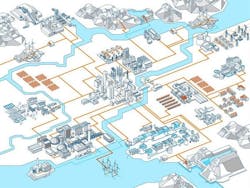ABB’s Maxine Ghavi describes how microgrids can improve the lives of hundreds of millions of people, while helping to meet national and global emissions targets.
Cutting carbon emissions while meeting the growing energy needs of an expanding global population requires innovative, pioneering solutions.
One is microgrids, powered by renewable energy.
Maxine Ghavi, director of ABB’s microgrids program
These small-scale grids are exceptionally flexible, bringing power to remote communities and facilities that might otherwise have to wait years or even decades for a grid connection. They are also ideal as back-up power sources for grid-connected installations in places prone to power outages.
Microgrids integrate multiple distributed generation sources including conventional diesel and gas, and/or renewables such as solar photovoltaic (PV), wind, hydroelectric, tidal and even thermal schemes like combined heat and power (CHP), together with energy storage. The microgrid provides the overall control to coordinate these resources to meet the requirements of industrial, residential or consumer loads.
They lend themselves perfectly to island communities and remote villages and towns. A notable example is the Azores island of Faial in the Atlantic, population 15,000, which has a self-contained microgrid powered by five wind turbines and six oil-fired generators. Others include the solar- and diesel-powered microgrids in the remote towns of Marble Bar and Nullagine in Western Australia. Thanks to grid stabilizing technology, which enables high solar-energy penetration, the towns now obtain close to 60 percent of their power from solar generation, saving approximately 400,000 liters of diesel and 1,100 tonnes of greenhouse gas emissions each year.
Microgrids have enormous potential in India and Africa, where more than 900 million people lack access to electricity. In sub-Saharan Africa, where two-thirds of the population – 620 million people – live without power, microgrids could dramatically speed up economic development. In India, they are likely to be the best solution for many of the 14,000 villages which the government has earmarked for electrification in the coming years under its “Power for all” initiative.
Experience shows that when a community gets electricity, the benefits start to be realized almost immediately. For example, bringing power to weavers and tailors in Barmer, an arid district in the Indian state of Rajasthan, pushed up their productivity by 50 percent and 40 percent respectively because they were able to work at night and avoid searing daytime temperatures. Children were able to study after dark, and the number attending school doubled in two years. Electricity also replaced kerosene, lowering fossil fuel emissions, reducing the danger of fires and easing health problems.
Microgrids will play a key role in a low-carbon future. (Photo credit: ABB)
Microgrids have important applications in industrial and commercial sites by helping to ensure power availability and quality. If they are connected to the main power grid, they also help to improve grid resiliency and reliability, for instance during extreme weather events. In cities affected by frequent power cuts, they are a clean and efficient alternative to diesel generators, which are highly polluting and expensive to run, pushing up the cost of doing business. In Kenya, for instance, 57 percent of businesses own generators, according to the World Bank.
[clickToTweet tweet=”Microgrids have a key role to play in a low-carbon future” quote=”Microgrids have a key role to play in a low-carbon future”]
Renewables-powered microgrids also use diesel for back-up power when the wind stops blowing or the sun goes down. However, thanks to advances in energy storage technology it is now possible to store excess renewable energy, further reducing the need for diesel. For instance, a newly upgraded microgrid on Kodiak Island, off Alaska’s south coast, derives virtually all of its 28 megawatts (MW) of electricity capacity from hydropower and wind, supported by two 1.5 MW battery systems that take over as soon as the wind stops blowing. Optimization of this complex energy mix was made possible by ABB’s flywheel grid stabilizing system that extends battery life, balances intermittencies from the wind farm, and reduces diesel consumption. A similar solution is being installed at a remote windfarm called Marsabit in northern Kenya, where the population of 5,000 relies exclusively on a wind- and diesel-powered microgrids.
ABB has also delivered a microgrid control system plus a containerized battery energy storage system for an integrated solar-diesel microgrid at its own premises in Johannesburg, South Africa. The microgrid can seamlessly disconnect and reconnect to the main grid in case of outages. On sunny days, it can run entirely on solar power, and has resulted in a CO2 reduction of over 1,000 tons per year.
The ability of microgrids to seamlessly separate and isolate themselves from the main grid when needed is an increasingly important consideration, especially for humanitarian organizations. The International Committee of the Red Cross (ICRC) recently asked ABB to supply solutions for a microgrid at its global logistics center in Nairobi, Kenya, which experiences frequent outages and power quality issues. Here again, ABB is providing a containerized battery energy storage system that works in parallel with the on-site solar/diesel generation, seamlessly disconnecting and reconnecting to the main grid in case of outages. This ensures a reliable power supply for the center, which delivers food and other essential items like medicines and relief supplies across the African continent.
As these examples demonstrate, the technology needed for the deployment of microgrids is now readily available. In addition, the cost of key technology components, such as solar photovoltaic and battery storage, will continue to decline as a result of the economies of scale and innovations in materials and manufacturing. Renewable energy is, in many cases, the most economical solution for electrification, with the levelized cost of electricity (LCOE) lower than diesel, provided the latter is not heavily subsidized.
Some countries have incentive-driven renewables programs, but very often no framework specifically for microgrids. This is starting to change; the United States Department of Energy, for instance, is working to encourage the development and deployment of microgrids, and the Indian government is promulgating federal and state policies under its “Power for all” initiative, to end regulatory uncertainty, which is in turn expected to unlock the level of investment required to scale up the industry.
With the right financing and business models that take account of the regulatory environment, microgrids could help to trigger development in rural areas, improving the lives of hundreds of millions of people, while helping to meet national and global emissions targets.
This article was submitted by Maxine Ghavi, director of ABB’s microgrids program. Maxine devises and develops the global business strategy for microgrids, working across the company’s divisions to identify and develop opportunities. All microgrid projects referred to in this article are ABB-enabled.


